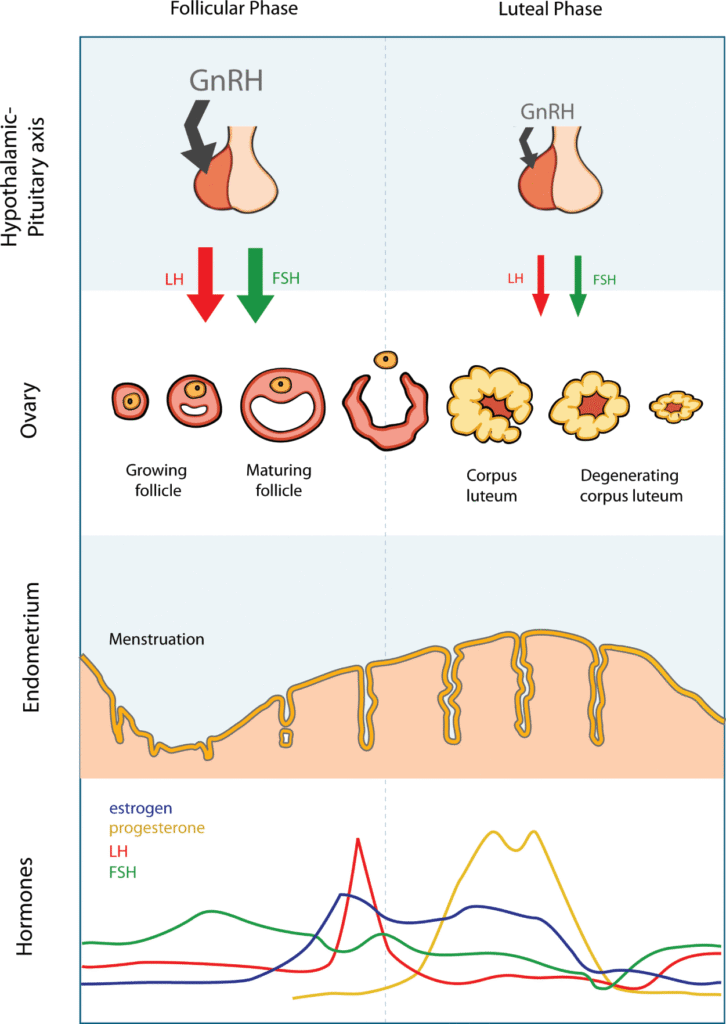Your menstrual cycle is a finely tuned hormonal symphony that involves the brain, ovaries, and uterus. When everything is in balance, your period arrives regularly, lasts a predictable number of days, and is manageable in terms of flow and symptoms.
But when hormones are too high, too low, or fluctuate unpredictably, it can disrupt the entire menstrual cycle — causing irregular periods, skipped cycles, heavy bleeding, intense PMS, or even infertility.
Let’s break down how hormonal imbalances affect your menstrual cycle, which hormones are involved, and what symptoms to watch out for.
🔄 Key Hormones That Regulate the Menstrual Cycle
- Gonadotropin-releasing hormone (GnRH) – from the brain
- Follicle-stimulating hormone (FSH) – stimulates egg development
- Luteinizing hormone (LH) – triggers ovulation
- Estrogen – builds up the uterine lining
- Progesterone – stabilizes the lining after ovulation
- Prolactin, testosterone, thyroid hormones, and insulin also play indirect roles
These hormones rise and fall in a specific pattern throughout the month. Any disruption in this rhythm can throw off your entire cycle.
🔍 What Is a Hormonal Imbalance?
A hormonal imbalance occurs when your body produces too much or too little of one or more hormones. Even small imbalances can interfere with the ovulation process, change the uterine lining, or affect how the body reacts to normal menstrual cues.
🩸 How Hormonal Imbalances Impact Each Phase of the Menstrual Cycle
1. Menstrual Phase (Day 1–5)
Problem: Low estrogen or thyroid imbalance
- If estrogen is too low, your uterine lining may not build up adequately — leading to light or missed periods.
- If thyroid hormones are off, you may experience very heavy or unusually light bleeding.
2. Follicular Phase (Day 1–13)
Problem: Low FSH or high prolactin
- Low FSH = inadequate egg development → delayed ovulation or anovulation (no ovulation)
- High prolactin (often due to stress or pituitary issues) can suppress FSH and LH, stopping ovulation altogether
3. Ovulation (Around Day 14)
Problem: Low LH surge or excess androgens (e.g., testosterone)
- Without a proper LH surge, ovulation doesn’t occur.
- Women with PCOS may have high testosterone, which disrupts ovulation and leads to cystic follicles and irregular cycles.
4. Luteal Phase (Day 15–28)
Problem: Low progesterone or estrogen dominance
- Low progesterone can cause short luteal phases, spotting, or early periods
- Estrogen dominance (too much estrogen relative to progesterone) may lead to PMS, breast tenderness, and heavy periods
⚠️ Common Hormonal Conditions That Affect the Menstrual Cycle
🥚 1. Polycystic Ovary Syndrome (PCOS)
- Excess androgens (male hormones) interfere with normal ovulation
- Leads to irregular or absent periods, acne, weight gain, and infertility
🧠 2. Hypothalamic Amenorrhea
- Caused by stress, eating disorders, or overexercise
- Low GnRH → Low FSH/LH → No ovulation or period
🦋 3. Thyroid Disorders
- Hypothyroidism: Can cause heavy, long periods, fatigue, weight gain
- Hyperthyroidism: Can cause light or missed periods, anxiety, weight loss
🍼 4. High Prolactin Levels (Hyperprolactinemia)
- Suppresses FSH and LH, delaying or stopping ovulation
- Often related to stress, pituitary tumors, or certain medications
🧪 5. Estrogen Dominance
- Too much estrogen relative to progesterone
- Causes heavy periods, PMS, fibroids, and bloating
🧂 6. Insulin Resistance
- Common in PCOS or obesity
- Disrupts ovarian function and can lead to anovulation
📋 Symptoms of Hormonal Imbalance Affecting Your Cycle
- Irregular periods (too frequent or infrequent)
- Missed periods (amenorrhea)
- Heavy or prolonged bleeding (menorrhagia)
- Painful periods (dysmenorrhea)
- Spotting between periods
- Severe PMS or PMDD
- Unexplained weight gain or loss
- Hair thinning, acne, or unwanted hair growth
- Mood swings, anxiety, or depression
🧬 Diagnosis: How Doctors Identify Hormonal Imbalances
Your doctor may use a combination of:
- Hormone blood tests: FSH, LH, estrogen, progesterone, prolactin, TSH, testosterone, insulin
- Pelvic ultrasound: To check for cysts, fibroids, or uterine lining abnormalities
- Medical history: Including stress levels, weight changes, medications, and menstrual tracking
- Physical exam: To check for signs like acne, hirsutism, or thyroid enlargement
🩺 Treatment Options
Treatment depends on the underlying cause:
| Condition | Treatment Options |
|---|---|
| PCOS | Birth control, metformin, anti-androgens |
| Thyroid disorder | Thyroid hormone therapy or antithyroid meds |
| Estrogen dominance | Progesterone therapy, dietary changes |
| High prolactin | Dopamine agonists, MRI if tumor suspected |
| Hypothalamic amenorrhea | Nutrition, reduced exercise, stress reduction |
| PMS/PMDD | SSRIs, hormonal therapy, lifestyle changes |
🌿 Natural Ways to Support Hormonal Balance
- Eat balanced meals rich in protein, fiber, and healthy fats
- Manage stress through mindfulness, therapy, or relaxation techniques
- Exercise moderately — avoid overtraining
- Get quality sleep (7–9 hours per night)
- Avoid hormone disruptors (like BPA in plastics or synthetic fragrances)
- Track your cycle to spot patterns and changes early
🧠 Final Thoughts: Listen to Your Cycle
Hormones are powerful messengers — and your menstrual cycle is one of the most sensitive indicators of hormonal health. If something feels off, your body is trying to tell you that something deeper may need attention.
If you’re dealing with ongoing irregularities, heavy bleeding, or other cycle-related issues, don’t ignore them. Early diagnosis and targeted treatment can help you regain balance and protect your overall health.



